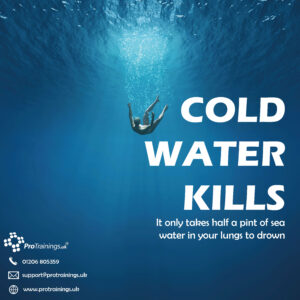 What is Cold Water Shock?
What is Cold Water Shock?
Cold water shock is a potentially dangerous condition that occurs when the body is exposed to water temperatures of 15°C or below. This sudden exposure can lead to a precursor to drowning, often underestimated by many.
Why Is It Dangerous?
Water below 15°C drastically impacts breathing and movement, posing significant risks throughout most of the year. In the UK and Ireland, average sea temperatures hover around 12°C. Rivers, such as the Thames, tend to be even colder, particularly in summer.
Symptoms and Causes
Upon entering cold water, blood vessels in the skin constrict, increasing blood flow resistance and heart rate. This extra strain on the heart can lead to heart attacks, even in the young and healthy. Additionally, the skin’s sudden cooling triggers an involuntary gasp. Breathing rates may increase uncontrollably, heightening panic and the risk of water inhalation into the lungs. Tragically, it takes only half a pint of sea water in the lungs for a grown man to start drowning, necessitating immediate medical attention.
Dealing with Cold Water Shock
In an unexpected plunge:
Take a Minute: The initial shock subsides within a minute. Avoid swimming immediately.
Relax and Float: Adopt a survival posture until you regain control.
Call for Help: If possible, seek assistance or swim to safety calmly.
For planned water activities:
Check Conditions: Always assess water temperature and overall conditions (see metoffice.gov.uk).
Wear Appropriate Gear: Use a wetsuit suitable for your activity duration and type.
Use Flotation Devices: A lifejacket or buoyancy aid can be lifesaving.
Our seas and rivers can incapacitate you within seconds. Treat water with respect and remember, not everyone can be saved despite best efforts. Stay informed, prepared, and cautious to enjoy water activities safely.
